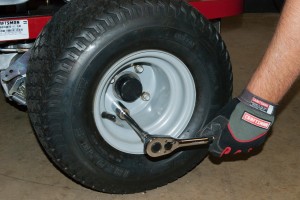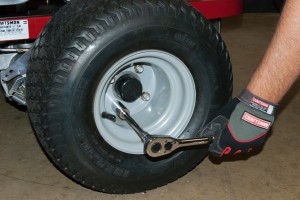How to adjust the neutral control on a zero-turn riding mower

This step-by-step repair guide gives instructions for adjusting a zero-turn riding mower’s neutral control. If your zero-turn riding mower creeps forward or backward when both lap bars are in the neutral position, adjust the neutral control following the instruction in this repair guide. See all our riding mower and lawn tractor DIY repair guides for more step-by-step instructions.
Use this process to adjust the neutral control on common Craftsman, Husqvarna, Troybilt, MTD, Cub Cadet and Toro zero-turn riding mowers.
This video explains how to adjust the neutral control on a zero-turn riding mower.
Instructions
- 01.
Loosen the lug nuts on both rear wheels
Move the mower to a work area on a hard, level surface. Don’t set the parking brake.
Loosen the lug nuts on both rear wheels, but don’t remove them.

PHOTO: Loosen the lug nuts.
- 02.
Jack up the rear
Place wheel chocks in front of and behind both front castor wheels.
Jack up the back of the mower to raise both rear wheels off the ground.
Place jack stands under both sides of the rear frame to support the mower.

PHOTO: Chock the front wheels.

PHOTO: Jack up the mower.
- 03.
Remove both rear wheels
Remove the lug nuts from the rear wheels and pull off both rear wheels.

PHOTO: Remove the lug nuts.

PHOTO: Remove the wheels.
- 04.
Start the engine
Place both lap bars in the neutral position.
Pushing the bars outward to lock them in position.
Start the engine and set the throttle to full RPM.
- 05.
Adjust the neutral setting
Check which wheel hub is moving.
On the side that moves, remove the linkage mounting screw and pull the control linkage off of the bracket.
Loosen the neutral adjustment screw.
Adjust the control bracket to stop the wheel hub from moving.
Tighten the neutral adjustment screw.
Shut the engine off.
Reconnect the control linkage.

PHOTO: Remove the linkage.
- 06.
Reinstall the rear wheels
Reinstall the rear wheels on the hubs. Reinstall the lug nuts and finger tighten them.

PHOTO: Reinstall the rear wheels.
- 07.
Lower the mower
Jack up the back of the mower and remove the jack stands.
Lower the rear of the mower to the ground.
Remove the front wheel chocks.
- 08.
Tighten the lug nuts
Set the parking brake and firmly tighten the rear wheel lug nuts.

PHOTO: Tighten the lug nuts.
Most common symptoms to help you fix your riding mowers & tractors
Choose a symptom to see related riding mower and lawn tractor repairs.
Main causes: worn or broken blade belt, broken belt idler pulley, blade clutch cable failure, bad PTO switch, damaged ma…
Main causes: faulty battery, bad alternator…
Main causes: punctured tire or inner tube, leaky valve stem, damaged wheel rim…
Main causes: dead battery, stale fuel, bad starter solenoid, ignition system problem, bad ignition interlock switch, clo…
Main causes: damaged tie rods, bent or worn wheel spindle, worn front axle, damaged sector gear assembly…
Main causes: shift lever needs adjustment, neutral control needs adjustment…
Main causes: clogged carburetor, damaged flywheel key, dirty spark plug, stale fuel, improper valve lash, engine needs a…
Main causes: worn or broken ground drive belt, bad seat switch, transaxle freewheel control engaged, transaxle failure, …
Main causes: unlevel mower deck, dull or damaged cutting blades, worn mandrel pulleys, bent mower deck, engine needs tun…
Most common repair guides to help fix your riding mowers & tractors
These step-by-step repair guides will help you safely fix what’s broken on your riding mower or lawn tractor.

How to replace a riding lawn mower rear tire
Your mower can’t run on a damaged rear tire. Here’s how to install a new one.…

How to replace a riding lawn mower blade
If a blade on your mower is dull or bent, replace it following the steps in this repair guide.…

How to replace a riding lawn mower fuel filter
Help your mower run better by replacing the fuel filter during your riding mower's annual tune-up.…
Effective articles & videos to help repair your riding mowers & tractors
Use the advice and tips in these articles and videos to get the most out of your riding mower or lawn tractor.

Learn about all the convenient features on our Sears PartsDirect website that make your parts purchases easier.…

Get answers to frequently asked questions about Sears and Sears PartsDirect.…

Check the starter solenoid, starter motor, wiring, battery and engine.…